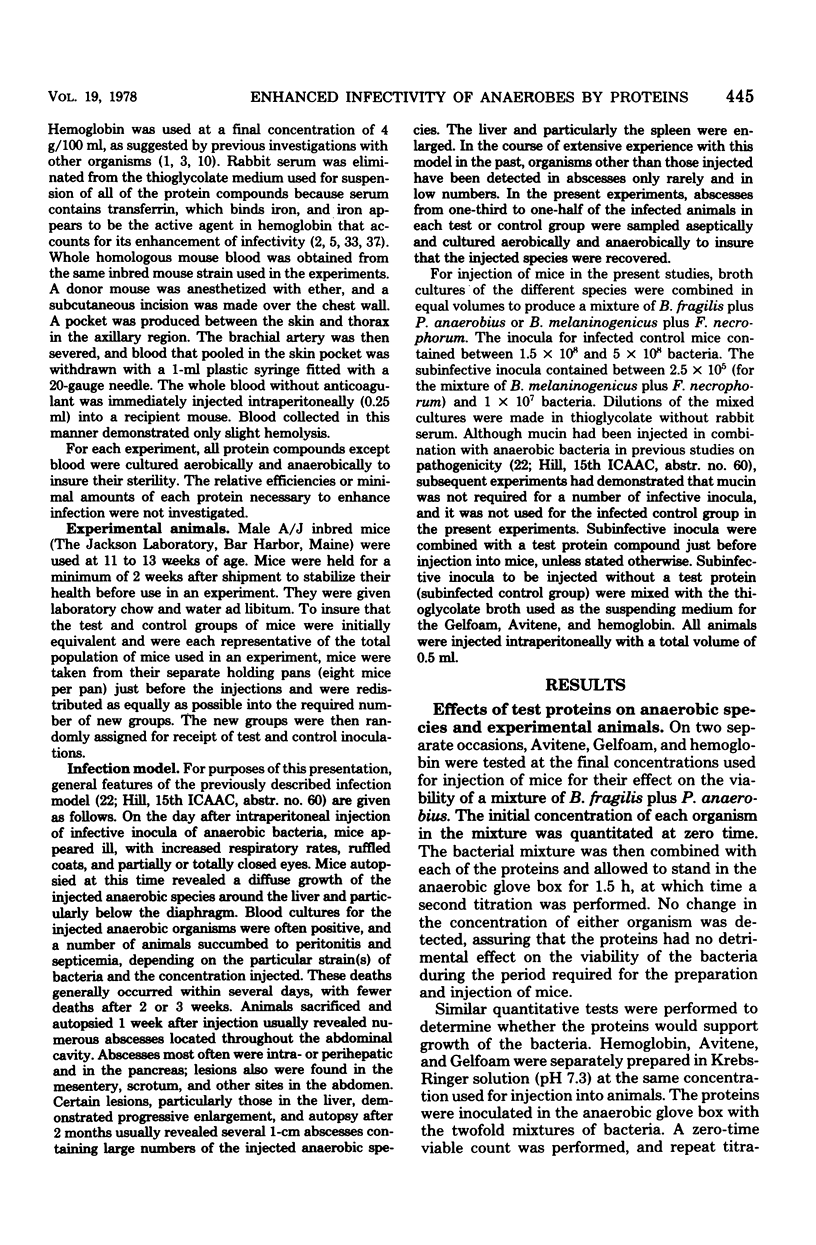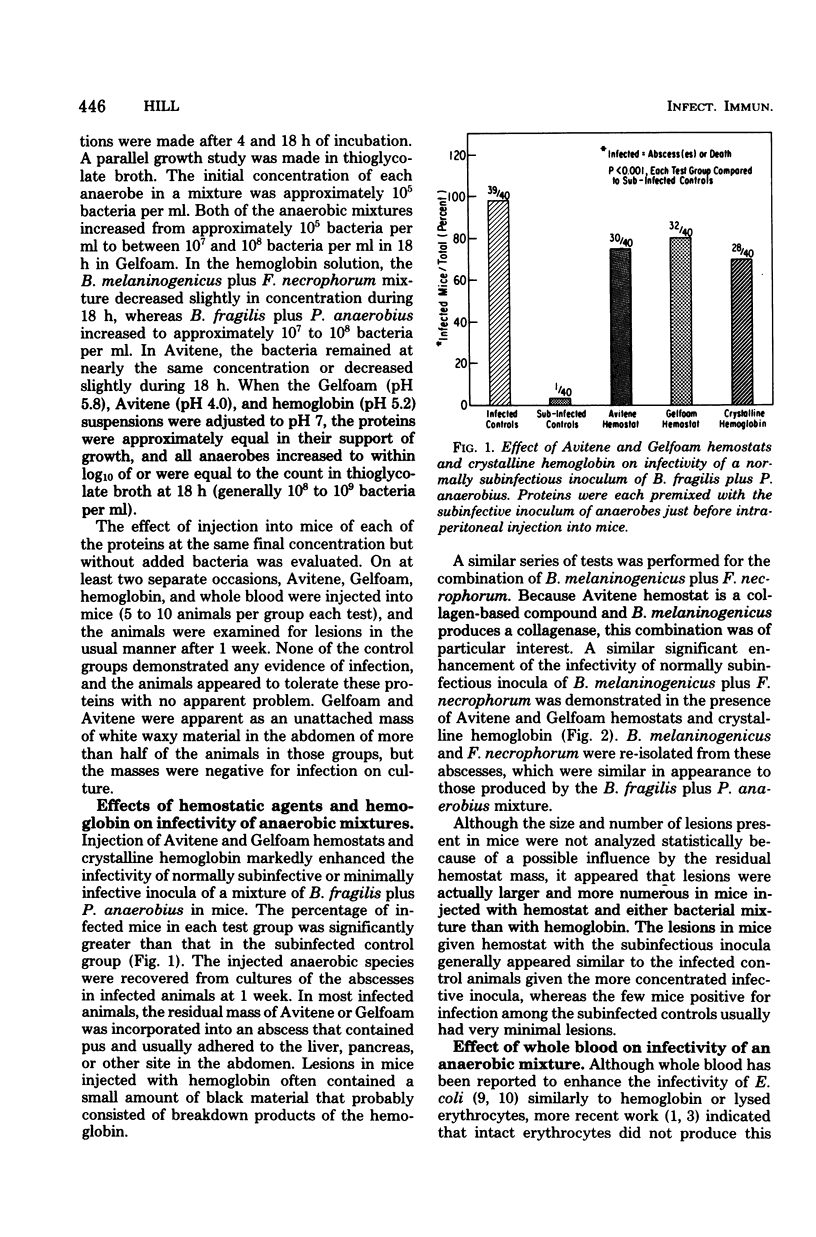Abstract
Certain foreign materials have been demonstrated to enhance the infectivity of aerobic and anaerobic bacteria. Whole blood and other protein compounds encountered in surgical settings or trauma were tested for their effect on infectivity of nonsporeforming anaerobic bacteria. Infectious synergistic mixtures of Bacteroides fragilis plus Peptostreptococcus anaerobius and Bacteroides melaninogenicus plus Fusobacterium necrophorum were each diluted to a barely noninfectious or minimally infectious concentration (subinfective inoculum) that was injected intraperitoneally into mice alone and in combination with test proteins. Infectivity was measured by deaths from sepsis or abscess(es) within the abdominal cavity at autopsy at 1 week. Two hemostatic agents, Gelfoam powder and Avitene (final concentrations, 10 mg/ml), and crystalline hemoglobin (4 g/100 ml) each produced a marked increase (P < 0.001) in the rate of infection when mixed with a normally subinfective inoculum of either bacterial mixture. Fresh homologous mouse blood (0.25 ml) injected intraperitoneally without anticoagulant also significantly enhanced infectivity (P < 0.01) of a subinfective inoculum of B. fragilis plus P. anaerobius. These studies demonstrated the capacity of whole blood, hemoglobin, and hemostatic agents to enhance the infectivity of certain nonsporeforming anaerobic bacteria. The high concentrations of anaerobic bacteria in the gastrointestinal, female genital, and respiratory tracts produce an increased risk of human infection after surgery or trauma in these sites; the protein agents studied here may further enhance infection.
Full text
PDF






Selected References
These references are in PubMed. This may not be the complete list of references from this article.
- Bornside G. H., Bouis P. J., Jr, Cohn I., Jr Enhancement of Escherichia coli infection and endotoxic activity by hemoglobin and ferric ammonium citrate. Surgery. 1970 Aug;68(2):350–355. [PubMed] [Google Scholar]
- Bornside G. H., Bouis P. J., Jr, Cohn I., Jr Hemoglobin and Escherichia coli, a lethal intraperitoneal combination. J Bacteriol. 1968 May;95(5):1567–1571. doi: 10.1128/jb.95.5.1567-1571.1968. [DOI] [PMC free article] [PubMed] [Google Scholar]
- Bornside G. H., Cohn I., Jr Hemoglobin as a bacterial virulence-enhancing factor in fluids produced in strangulation intestinal obstruction. Am Surg. 1968 Jan;34(1):63–67. [PubMed] [Google Scholar]
- Bullen J. J., Cushnie G. H., Rogers H. J. The abolition of the protective effect of Clostridium welchii type A antiserum by ferric iron. Immunology. 1967 Mar;12(3):303–312. [PMC free article] [PubMed] [Google Scholar]
- Bullen J. J., Leigh L. C., Rogers H. J. The effect of iron compounds on the virulence of Escherichia coli for guinea-pigs. Immunology. 1968 Oct;15(4):581–588. [PMC free article] [PubMed] [Google Scholar]
- CHAMBERLAIN B. E., DELMONICO J. E., Jr, GREGG R. O. Effect of gelfoam on the integrity of intestinal anastomosis. Am J Surg. 1951 Oct;82(4):462–465. doi: 10.1016/0002-9610(51)90374-1. [DOI] [PubMed] [Google Scholar]
- Calver G. A., Kenny C. P., Lavergne G. Iron as a replacement for mucin in the establishment of meningococcal infection in mice. Can J Microbiol. 1976 Jun;22(6):832–838. doi: 10.1139/m76-120. [DOI] [PubMed] [Google Scholar]
- DAVIS J. H., YULL A. B. A possible toxic factor in abdominal injury. J Trauma. 1962 May;2:291–300. doi: 10.1097/00005373-196205000-00006. [DOI] [PubMed] [Google Scholar]
- DAVIS J. H., YULL A. B. The red blood cell: an essential component of the toxicity of strangulation intestinal obstruction. Proc Soc Exp Biol Med. 1961 Oct;108:252–253. doi: 10.3181/00379727-108-26906. [DOI] [PubMed] [Google Scholar]
- Filler R. M., Sleeman H. K. Pathogenesis of peritonitis. I. The effect of Escherichia coli and hemoglobin on peritoneal absorption. Surgery. 1967 Mar;61(3):385–392. [PubMed] [Google Scholar]
- Finegold S. M., Rosenblatt J. E. Practical aspects of anaerobic sepsis. Medicine (Baltimore) 1973 Jul;52(4):311–322. doi: 10.1097/00005792-197307000-00010. [DOI] [PubMed] [Google Scholar]
- Fletcher J., Goldstein E. The effect of parenteral iron preparations on experimental pyelonephritis. Br J Exp Pathol. 1970 Jun;51(3):280–285. [PMC free article] [PubMed] [Google Scholar]
- Ganzoni A. M., Puschmann M. An other look at iron: role in host pathogen interaction. Blut. 1975 Nov;31(5):313–322. doi: 10.1007/BF01634148. [DOI] [PubMed] [Google Scholar]
- Georgiade N. G., King E. H., Harris W. A., Tenery J. H., Schlech B. A. Effect of three proteinaceous foreign materials on infected and subinfected wound models. Surgery. 1975 Apr;77(4):569–576. [PubMed] [Google Scholar]
- Gorbach S. L., Bartlett J. G. Anaerobic infections (second of three parts). N Engl J Med. 1974 May 30;290(22):1237–1245. doi: 10.1056/NEJM197405302902207. [DOI] [PubMed] [Google Scholar]
- Gorbach S. L., Bartlett J. G. Anaerobic infections (third of three parts). N Engl J Med. 1974 Jun 6;290(23):1289–1294. doi: 10.1056/NEJM197406062902305. [DOI] [PubMed] [Google Scholar]
- Gorbach S. L., Bartlett J. G. Anaerobic infections. 1. N Engl J Med. 1974 May 23;290(21):1177–1184. doi: 10.1056/NEJM197405232902106. [DOI] [PubMed] [Google Scholar]
- Hau T., Nelson R. D., Fiegel V. D., Levenson R., Simmons R. L. Mechanisms of the adjuvant action of hemoglobin in experimental peritonitis. 2. Influence of hemoglobin on human leukocyte chemotaxis in vitro. J Surg Res. 1977 Mar;22(3):174–180. doi: 10.1016/0022-4804(77)90131-7. [DOI] [PubMed] [Google Scholar]
- Hill G. B., Osterhout S., Pratt P. C. Liver abscess production by non-spore-forming anaerobic bacteria in a mouse model. Infect Immun. 1974 Mar;9(3):599–603. doi: 10.1128/iai.9.3.599-603.1974. [DOI] [PMC free article] [PubMed] [Google Scholar]
- Hill G. B. Therapeutic evaluation of minocycline and tetracycline for mixed anaerobic infection in mice. Antimicrob Agents Chemother. 1977 Apr;11(4):625–630. doi: 10.1128/aac.11.4.625. [DOI] [PMC free article] [PubMed] [Google Scholar]
- KRAVITZ S. C., BREED C. N., Jr Staphylococcus aureus bacteremia; report of a case with cure by combined antibiotic therapy and surgical eradication of an unusual focus of infection. J Am Med Assoc. 1951 Mar 17;145(11):819–821. doi: 10.1001/jama.1951.72920290009008d. [DOI] [PubMed] [Google Scholar]
- Kochan I. The role of iron in bacterial infections, with special consideration of host-tubercle bacillus interaction. Curr Top Microbiol Immunol. 1973;60:1–30. doi: 10.1007/978-3-642-65502-9_1. [DOI] [PubMed] [Google Scholar]
- LINDSTROM P. A. Complications from the use of absorbable hemostatic sponges. AMA Arch Surg. 1956 Jul;73(1):133–141. doi: 10.1001/archsurg.1956.01280010135018. [DOI] [PubMed] [Google Scholar]
- MERGENHAGEN S. E., THONARD J. C., SCHERP H. W. Studies on synergistic infections. I. Experimental infections with anaerobic streptococci. J Infect Dis. 1958 Jul-Aug;103(1):33–44. doi: 10.1093/infdis/103.1.33. [DOI] [PubMed] [Google Scholar]
- Miles A. A., Khimji P. L. Enterobacterial chelators of iron: their occurrence, detection, and relation to pathogenicity. J Med Microbiol. 1975 Nov;8(4):477–490. doi: 10.1099/00222615-8-4-477. [DOI] [PubMed] [Google Scholar]
- Miles A. A., Pillow J., Khimji P. L. The action of iron on local Klebsiella infection of the skin of the guinea-pig and its relation to the decisive period in primary infective lesions. Br J Exp Pathol. 1976 Apr;57(2):217–242. [PMC free article] [PubMed] [Google Scholar]
- Pearson H. A., Robinson J. E. The role of iron in host resistance. Adv Pediatr. 1976;23:1–33. [PubMed] [Google Scholar]
- Rogers H. J., Bullen J. J., Cushnie G. H. Iron compounds and resistance to infection. Further experiments with Clostridium welchii type A in vivo and in vitro. Immunology. 1970 Oct;19(4):521–538. [PMC free article] [PubMed] [Google Scholar]
- Simmons R. L., Diggs J. W., Sleeman H. K. Pathogenesis of peritonitis. 3. Local adjuvant action of hemoglobin in experimental E. coli peritonitis. Surgery. 1968 May;63(5):810–815. [PubMed] [Google Scholar]
- Sleeman H. K., Diggs J. W., Hendry W. S., Filler R. M. Pathogenesis of peritonitis. II. The effect of Escherichia coli and adjuvant substances on peritoneal abosrption. Surgery. 1967 Mar;61(3):393–398. [PubMed] [Google Scholar]
- Weinberg E. D. Iron and susceptibility to infectious disease. Science. 1974 May 31;184(4140):952–956. doi: 10.1126/science.184.4140.952. [DOI] [PubMed] [Google Scholar]
- Wilkins T. D., Smith L. D. Chemotherapy of an experimental Fusobacterium (Sphaerophorus) necrophorum infection in mice. Antimicrob Agents Chemother. 1974 Jun;5(6):658–662. doi: 10.1128/aac.5.6.658. [DOI] [PMC free article] [PubMed] [Google Scholar]


